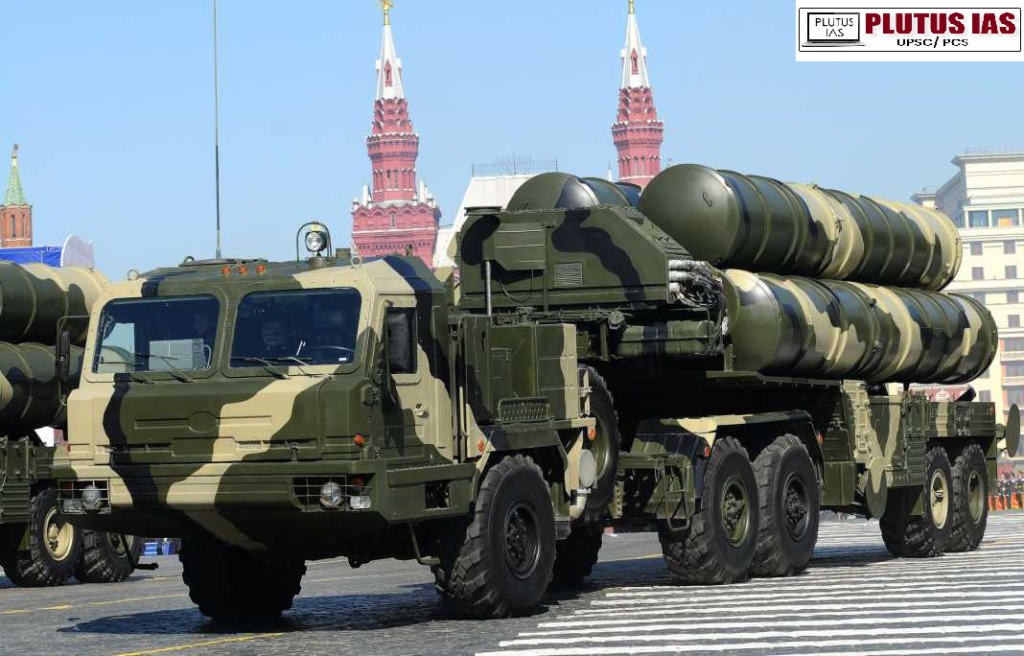09 May S-400 Triumf: A Game-Changer in Strengthening India’s Air Defence Capabilities
This article covers “Daily Current Affairs” and the Topic S-400 Triumf: A Game-Changer in Strengthening India’s Air Defence Capabilities.
SYLLABUS MAPPING:
GS- 3-Science and technology- S-400 Triumf: A Game-Changer in Strengthening India’s Air Defence Capabilities
FOR PRELIMS
What is the S-400 missile system? Why is it important for India’s defence?
FOR MAINS
What are the main features of the S-400 missile system?
Why in the News?
Operation Sindoor has recently made headlines due to its bold and decisive execution by Indian armed forces, targeting terrorist camps across the border in Pakistan and Pakistan-occupied Kashmir (Pok). The operation was launched as a pre-emptive counter-terror measure, aiming to dismantle terror infrastructure threatening Indian security. In retaliation, Pakistan initiated a coordinated multi-wave offensive involving drones and missiles aimed at key Indian cities and military installations, including Awantipora, Srinagar, Jammu, Pathankot, Amritsar, Ludhiana, and Bhuj. However, India’s advanced S-400 air defence system, codenamed “Sudarshan Chakra,” effectively neutralised the aerial threats, marking a significant demonstration of India’s enhanced defensive preparedness and strategic deterrence capabilities.

What is S-400?
The S-400 Triumf is an advanced long-range air defence missile system developed by Russia, designed to detect, track, and destroy a variety of aerial threats including aircraft, drones, cruise missiles, and ballistic missiles. With a range of up to 400 km and the ability to engage multiple targets simultaneously, it is considered one of the most powerful surface-to-air defence systems in the world. The system uses multiple types of missiles to create a layered defence shield. Its radar can track stealth targets and operate effectively in complex combat environments.
Features of S-400
1. Multi-Target Capability: Can track up to 80 targets and engage 36 targets simultaneously, ensuring robust defence even during large-scale aerial attacks.
2. Range: Provides long-range interception with a strike range of up to 400 km for aircraft and 40–60 km for ballistic missiles, depending on the missile used.
3. Altitude Coverage: Can engage targets at altitudes ranging from 10 meters to 30 kilometres, offering protection against both low-flying drones and high-altitude threats.
4. Missile Versatility: Can fire a mix of missiles like 40N6 (400 km), 48n6 (250 km), 9M96E2 (120 km), and 9M96E (40 km), allowing layered and flexible defence.
5. 360-Degree Coverage: Delivers comprehensive all-around protection, making it effective against multi-directional and simultaneous attacks.
6. Advanced Threat Detection: Equipped with powerful radars like the 91N6E Big Bird and 92N6E Grave Stone, it can detect stealth aircraft, cruise missiles, UAVs, and even some hypersonic threats.
7. Rapid Deployment: The entire system, including command vehicles, launchers, and radar units, can be deployed in under 5–10 minutes, enabling swift operational readiness.
8. Integrated Command System: S-400 can be linked with other defence systems like the Indian Integrated Air Command and Control System (IACCS), enhancing coordination and battlefield awareness.
9. Combat Proven and Exported: Already deployed by Russia, and acquired by countries like India, China, and Turkey, the system’s performance in actual conflict zones has proven its reliability and effectiveness.
Why S-400 is Important for India
1. Enhanced Air Defence: Provides multi-layered protection against aircraft, missiles, UAVs, and ballistic missiles. Range of up to 400 km, covering key cities and strategic assets.
2. Strategic Deterrence: Against Pakistan Covers large portions of Pakistani airspace, deterring aerial threats.
3. Against China: Tracks and intercepts Chinese aircraft, AWACS, and aerial refuellers from within Indian territory.
4. Technological Superiority: Advanced radars, tracking, and missile capabilities surpass regional systems like HQ-9 and Patriot.Can track 300 targets and engage 36 simultaneously.
5. Force Multiplier for IAF: Protects Indian airspace, allowing IAF assets to focus on offensive operations.
6. Integration with Indigenous Systems: Complements systems like Akash and MRSAM, forming a layered defence network.
7. Sea Denial: Tracks and neutralises naval aircraft and ships, enhancing coastal security.
8. Countering Emerging Threats: Designed to intercept stealth aircraft, drones, and low-altitude missiles.
9. Strategic Autonomy: Demonstrates India’s independent defence policy, resisting external pressures (e.g., CAATSA sanctions).
Conclusion
The S-400 Triumf is a critical asset for India’s national security, strengthening its air defence and enhancing deterrence against both regional and global threats. With its advanced capabilities, including the ability to track and neutralise a variety of aerial threats, the S-400 provides multi-layered protection to key cities, military installations, and vital infrastructure. In the context of Operation Sindoor, the S-400’s role in effectively neutralising the Pakistani drone and missile threats highlights its strategic importance in defending India’s sovereignty and securing its airspace. The acquisition of the S-400 not only bolsters India’s air defence but also complements its indigenous defence systems, creating a robust and integrated security framework. It enhances India’s strategic autonomy, allowing it to make independent defence decisions, particularly in resisting foreign pressures, such as the CAATSA sanctions.
Download Plutus IAS Current Affairs (English) 09th May 2025
Prelims Questions
Q. With reference to the S-400 Triumf missile system, consider the following statements:
1. It can engage aerial threats at a range of up to 400 km.
2. It has been developed by the United States and deployed by NATO forces.
3. It supports multiple missile types for layered air defence.
Which of the statements given above is/are correct?
A. 1 and 3 only
B. 2 and 3 only
C. 1 only
D. 1, 2 and 3
Answer: A
Mains Questions
Q. Examine the strategic significance of the S-400 Triumf missile system for India’s national security. What are the key challenges in its deployment and integration into India’s defence architecture?
(250 words, 15 marks)




No Comments